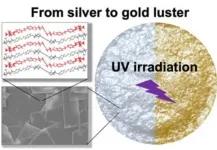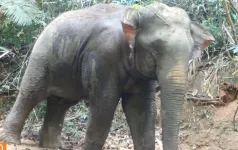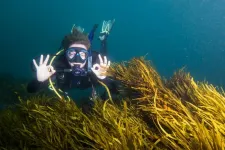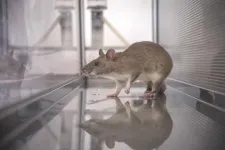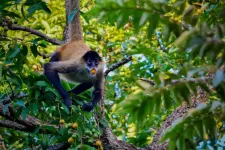(Press-News.org)
Societies of the past and present have given high regard to precious metals like gold and silver. Both metals remind us of nobility and luxury. However, they are quite expensive, which restricts their applications. Therefore, materials with attractive but artificial gold- and silver-like metallic lusters are popular, finding use in jewelry, reflective materials, inks, and cosmetics.
Unfortunately, typical metallic luster materials cause environmental harm, rendering them unsustainable. Thus, scientists are actively searching for metal-free alternatives. In this direction, the research fraternity has examined organics such as thiophene, pyrrole, porphyrin, azobenzene, and stilbene derivatives and found some success in creating materials whose colors can be tuned by external stimuli while maintaining the metallic luster. However, the task still remains challenging.
Recently, a group of researchers from Chiba University, led by Professor Michinari Kohri and Kyoka Tachibana from the Graduate School of Engineering, in collaboration with scientists from Mitsubishi Pencil Co., Ltd., Tokyo University of Science, Keio University, and Yamagata University, has demonstrated the preparation of a metallic luster material that changes color from silver to gold under UV irradiation. Their findings were published in ACS Applied Materials & Interfaces on September 14, 2024.
Highlighting the motivation behind this study, Prof. Kohri says, “Expanding on our earlier findings on biomimetic metallic luster materials, we conducted a targeted search for molecular structures capable of transitioning between silver and gold. This effort resulted in the identification of a novel material with desirable properties.”
In this study, researchers developed diacetylene (DA) derivative-based luster materials incorporating stilbenes via linkers at both ends, denoted as DS-DAn (where n represents the linker carbon number, ranging from 1 to 6). Varying n yielded diverse metallic luster and color change behaviors.
After several innovative experimental trials, the researchers observed that the stacked structure of platelet crystals comprising DS-DA1, the derivative with the shortest linker carbon chain, had a silver look. Its luster notably turned to gold upon UV irradiation, a remarkable external stimulus-based behavior. The team attributed this to the unique crystal structure of DS-DA1 with two coexisting assembled states, revealing that partial topochemical polymerization (a polymerization method performed by monomers that are aligned in the crystal state) of DA within the structure modified its color tone from silver to gold.
The silver luster material developed in this study can express a golden luster selectively in specific areas using only light irradiation. It is also possible to add gradation colors of gold and silver. Thus, it has the potential to be useful in a variety of applications, such as decorative items, printing inks, and cosmetics.
“By eliminating metal components, our innovative material minimizes environmental footprint and weight. Moreover, its suitability for UV laser-based drawing techniques opens up new possibilities for high-end decorative printing. Further exploration of molecular structures may make it possible to express a wider variety of glossy colors,” concludes Prof. Kohri, optimistically.
In summary, this work advances the fundamental science of DA polymerization and unlocks new opportunities for metallic luster materials with desirable properties in photomask patterning and UV laser lithography.
About Professor Michinari Kohri
Michinari Kohri obtained a Ph.D. in Engineering from Tohoku University in 2007. He currently holds the title of Professor at the Department of Applied Chemistry and Biotechnology, Graduate School of Engineering, Chiba University. His research is centered around polymer chemistry, colloid chemistry, and functional materials, with a particular focus on structural colors, biomass upcycling, and soft magnetic materials. He has published over a hundred papers on these topics and is a member of various scientific societies, including The Chemical Society of Japan, The Society of Polymer Science (Japan), and The Japanese Liquid Crystal Society.
END
In space exploration, long-distance optical links can now be used to transmit images, films and data from space probes to Earth using light. But in order for the signals to reach all the way and not be disturbed along the way, hypersensitive receivers and noise-free amplifiers are required. Now, researchers at Chalmers University of Technology, in Sweden, have created a system that, with a silent amplifier and record-sensitive receiver, paves the way for faster and improved space communication.
Space communication systems are increasingly based on optical laser beams rather than radio waves, as the signal loss has been shown to be less when light is used ...
Embargoed Until 10/30/24 at 7 am
PhD in Public Health candidate Elaine Russell and her mentor Kenneth Griffin, professor in the department of Global and Community Health, in George Mason University’s College of Public Health, worked with Tolulope Abidogun, also a PhD in Public Health student, and former Global and Community Health professor Lisa Lindley, now of Lehigh University, to analyze data from the American College Health Association National College Health Assessment (ACHA-NCHA III) in an effort to understand how university ...
PHNOM PENH, Cambodia (October 30, 2024) – The first-ever camera trap study of the Central Cardamom Mountains Landscape has recorded 108 species, 23 of which are listed at risk (Vulnerable or above) on the IUCN Red List, underscoring the significance of the region as a global stronghold for biodiversity and rare and threatened species.
Editors please note: Use these links to access camera trap footage and the full report.
The report, released today by the Cambodian Ministry of Environment (MoE), the United States Agency ...
An international team of geoscientists led by a volcanologist at Rutgers University-New Brunswick has discovered that, contrary to present scientific understanding, ancient volcanoes continued to spew carbon dioxide into the atmosphere from deep within the Earth long past their period of eruptions.
In doing so, the research team has solved a long-standing mystery over what caused prolonged episodes of warming during turning points in Earth’s climate history. The work is detailed in today’s issue of the journal Nature Geoscience.
“Our ...
In the face of increased human pressures and climate change, a team of Australian scientists led by Dr Georgina Wood at Flinders University have launched a new online tool to assist marine managers and restoration experts to bolster the resilience of marine habitat-forming species.
The ‘Reef Adapt’ initiative, developed by experts from the NSW Department of Primary Industries and Regional Development (NSW DPIRD), Flinders University and The University of Western Australia (UWA), aims to expand the tools available to promote diverse, adaptable and resilient ecosystems.
Described in a new article in Communications Biology, Reef Adapt harnesses genetic data ...
"Sustainable development pathways are strategies that prevent dangerous climate change while at the same time moving towards a world that allows people to prosper on a healthy planet,” explains Bjoern Soergel, scientist at the Potsdam Institute for Climate Impact Research PIK and lead author of the study published in Environmental Research Letters. This is the essence of the 17 SDGs agreed by the United Nations in 2015. “Our analysis shows that all three sustainable development pathways are far more effective than our current ‘business as usual’. They drive substantial progress towards the SDGs, for example reducing the number of people in extreme poverty ...
In the past, African giant pouched rats have learned to detect explosives and the tuberculosis-causing pathogen. Now, a team of researchers have trained these rats to pick up the scent of pangolin scales, elephant ivory, rhino horn, and African blackwood. These animals and plants are listed as threatened and at high danger of extinction.
“Our study shows that we can train African giant pouched rats to detect illegally trafficked wildlife, even when it has been concealed among other substances,” ...
Electrons spin even without an electric charge and this motion in condensed matter constitutes spin current, which is attracting a great deal of attention for next-generation technology such as memory devices. An Osaka Metropolitan University-led research group has been able to gain further insight into this important topic in the field of spintronics.
To investigate the characteristics of spin currents, OMU Graduate School of Science Professor Katsuichi Kanemoto’s group designed a multilayer device consisting of a ferromagnetic layer and an organic semiconductor ...
Anecdotes abound of wildlife behaving “drunk” after eating fermented fruits, but despite this, nonhuman consumption of ethanol has been assumed to be rare and accidental. Ecologists challenge this assumption in a review publishing October 30 in the Cell Press journal Trends in Ecology & Evolution. They argue that since ethanol is naturally present in nearly every ecosystem, it is likely consumed on a regular basis by most fruit- and nectar-eating animals.
“We're moving away from this anthropocentric view that ethanol is just something ...
While pancreatic cancer rates are rising in people under age 50, a new survey conducted by The Ohio State University Comprehensive Cancer Center – Arthur G. James Cancer Hospital and Richard J. Solove Research Institute (OSUCCC – James) shows most people continue to believe that pancreatic disease affects only the elderly – and that there is nothing they can do to reduce their risk.
For this survey, respondents were asked about risk factors for pancreatic cancer. More than half (53%) of adults under age 50 said they would not recognize the early signs or symptoms of the disease, and more than one third (37%) believe there is ...
